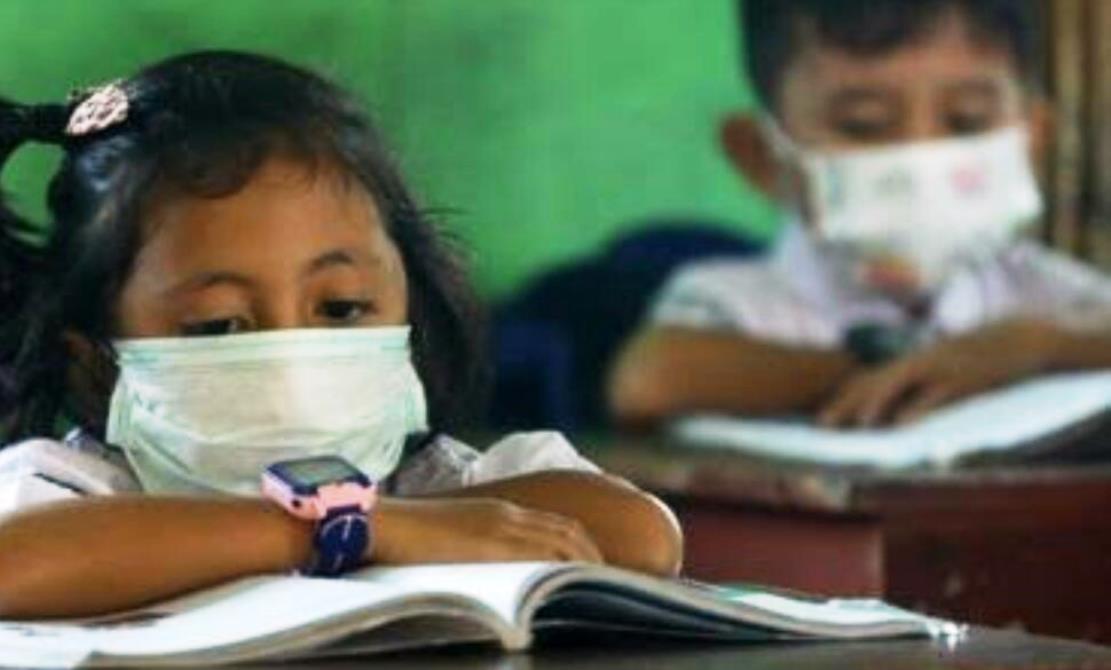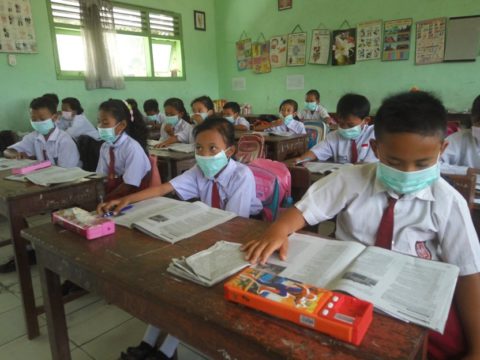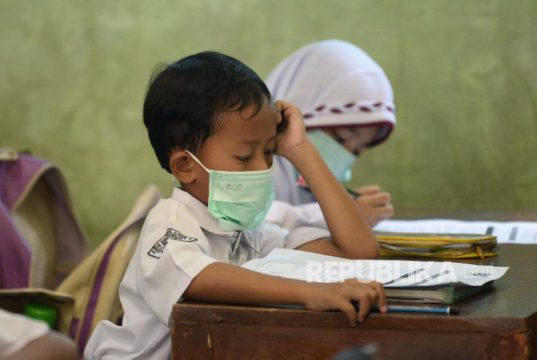The Central Government of Indonesia in Jakarta has authorized the reopening of classroom teaching in “green” and “yellow” zones – areas considered at lower risk of COVID-19 contagion.
Meanwhile, schools situated in “orange” and “red” zones, considered most at risk of coronavirus infection, are under orders to remain closed.
Speaking at a press conference in Jakarta and quoted by Tribun-Bali.com, the head of the Task Force for the Mitigation of COVID-19, Doni Monardo, said on Friday, 07 August 2020: “There are 163 yellow zones considered safe for holding face-to-face teaching as stipulated under policies from the Ministry of Education and Culture. The Friday press conference was also attended by the Minister of Education and Culture, Nadiem Makarin; Coordinating Minister for Human Development and Cultural Affairs, Muhadjir Effendy; and the Mister of Religious Affairs, Fachrul Razi.
Of the 163 “yellow zones” in Indonesia, two regencies in Bali are classified as “yellow” – Jembrana and Tabanan. These two areas in Bali can join the areas designated as “green” in Bali and are allowed to reopen their classrooms.
Doni explained that the conditions of the Government for operating schools in yellow zones are almost the same as the requirements for schools in green zones enjoying the lowest rate of infection. Adding: “The requirements for yellow zones are almost the same as green zones. This means that the decision to reopen schools and conduct face-to-face education remains with the Regents in charge of each region.”
“If we look at the map as of 2 August 2020, there are 163 yellow zones, where hopefully, face-to-face learning activities can take place under the Ministry of Education and Culture policies. The procedure in yellow zones is almost the same as the green zone,” Doni said.
Seeking clarification on Friday, 07 August 2020, Tribun-Bali.com contacted the head of Education, Youth, and Sports Department (Disdikpora) for the Province of Bali, Ketut Ngurah Boy Jayawibawa. Boy said he was attending ceremonies and had not yet had the opportunity to study the policy on school reopenings issued from Indonesia’s capital city.
Boy Jayawibawa explained that the opening of schools in Bali located in the yellow zones would be referred to the Chairman of the Provincial Task Force for the Mitigation of COVID-19. Boy added: “Later, schools may not be opened immediately. At the very least, first, there should be trial simulations conducted. For instance, in Denpasar, not all schools are opened immediately. We need to check which ones are ready.”
Boy said his office would also look into the learning environment in determining if schools should be reopened. “Many schools are waiting to reopen. We have prepared all the protocols. With protocols in hand, it means all is in hand for the school to reopen,” he said.
Initially, only schools in green zones with zero new cases of coronavirus were designated to reopen. The permission was granted to resume courses for the 2020/2021 school year that starts in July 2020. The decision to open or not was left in the hands of the school, the local education department, and the local Government. Each school is required to implement strict health protocols.
A Matter of Local Choice
The Minister of Education and Culture, Nadiem Makarim, emphasized that the policy on reopening schools located in yellow zones was not being forced on local education management. Nadiem acceded that face-to-face learning can be delayed whenever local Government does not yet feel ready to reopen its schools. Explaining: “Although reopening is allowed, if the principal, the head of the local education service, and the head of the regional education office feel that they are not ready, then they do not have to start face-to-face learning.”
“Moreover,” said Makarim, “in instances where the local Government is ready, but the school is not ready, face-to-face learning will not be commenced. Each school principal and school committee may decide whether or not the school is ready to do face-to-face learning.”
Finally, parents can also decide not to allow their children to participate in face-to-face learning if they have concerns about the risk of COVID-19 transmission at their children’s school.
Makarim said: “If parents do not allow children to go to school because they are still uncomfortable with the risk, then it is the prerogative and the right of each parent to decide if their children should return to school.”
Speaking at the same press conference, the Coordinating Minister for Human Development and Cultural Affairs, Muhadjir Effendy, reviewed the online learning activities that have been carried out in Indonesia over the past four months, thanking those who had assisted in helping create and conduct online education.
Muhadjir continued explaining that the authority of whether or not to reopen schools in yellow zones varies depending on the level of education involved. “More specifically, in the case of grade school (SD) and Junior High (SMA) levels remains the responsibility and authority of the regency and city governments. Education up to junior high (SMP) is the responsibility of the city and regency governments, while high school (SMA) and Trade Schools (SMK) are the responsibility of the provincial government.”
“As regards religious boarding schools (madrasa), this is an area that is the absolute matter for the Ministry of Religion to decide,” said Muhahdjir.
A Maximum of 18 Students
Nadiem told the press conference that discussions related to the opening of schools in yellow zones applies to trade schools (SMK), high schools (SMA), junior high schools (SMP), and grade schools (SD). “The opening of pre-schools (PAUD) can only be done two months after the face-to-face implementation begins,” said Makarim.
He also stipulated that face to face education can be done in classes that handle a maximum of 18 students. This is a reduction of 50% in the number of students sitting in one classroom and must now be carried out by schools on a rotational basis.
Laying down the rules, the Education Minister said: “The maximum capacity rule must be applied. Like it or not, shifting must be done. SD, SMP, SMA capacity is limited to 50%. A rotation system must be used. There is also mandatory use of masks, hand washing, hand sanitizing, a physical distancing of 1.5 meters, and no physical contact.”
Makarim said student and school personnel who display symptoms of Covid-19 or suffer from any known co-morbidity are not allowed to attend the reopened schools.
All school principals are asked to carry out a checklist addressing school readiness before implementing any program of face-to-face learning.
Nadiem reiterated that both schools and parents must agree beforehand to re-implement face-to-face learning.
Makarim said principals are obliged to perform COVID-19 checklists, be ready to conduct face-to-face learning, ensure cleanliness protocols are in operation, identify access to health facilities, and use thermal scanners to check temperatures and secure agreement between the education unit and parents that they all accept face-to-face learning.
Nadiem is Preparing an Emergency Curriculum
The Ministry of Education and Culture (Kemendikbud) is preparing an emergency curriculum for schools that are still using distance learning.
Minister of Education and Culture Nadiem Makarim revealed that the emergency curriculum for each level of education aims to help students via specific study modules.
“For SD, SMP, and SMA doing distance learning, we have compiled an emergency curriculum that will simplify basic competencies to help those who are most affected,” said Makarim.
Nadiem said the distance learning curriculum will be valid until the end of the school year and is focused on essential subjects.
Explaining further, the Minister said: “The emergency curriculum is what teachers have been waiting for for a long time. The emergency curriculum reduces basic competencies in every subject but has an essential focus. So it is not broad, but (still) rather broad.”
However, the Government’s emergency curriculum is not mandatory for all schools. Schools that have simplified the curriculum on their own can still use their own curriculum.
For the implementation of this curriculum to run smoothly, the Ministry of Education and Culture also relaxes the burden imposed on the teaching staff.
“It is essential that this process, which is so difficult at this critical time, must be carried out in cooperation with all parties. Local Government, schools, and parents must all work together to ensure our children are still learning. Of course, it cannot be 100 percent optimal,” Makarim said.
“We need community participation; we require parental involvement and assistance from health services. We have to ensure our children learn healthily and safely, “he added.




